外研版(2019)必修 第一册Unit 6 At One With Nature Using language 语法课件(共36张PPT)
文档属性
| 名称 | 外研版(2019)必修 第一册Unit 6 At One With Nature Using language 语法课件(共36张PPT) |  | |
| 格式 | pptx | ||
| 文件大小 | 5.5MB | ||
| 资源类型 | 教案 | ||
| 版本资源 | 外研版(2019) | ||
| 科目 | 英语 | ||
| 更新时间 | 2024-08-05 21:28:59 | ||
图片预览

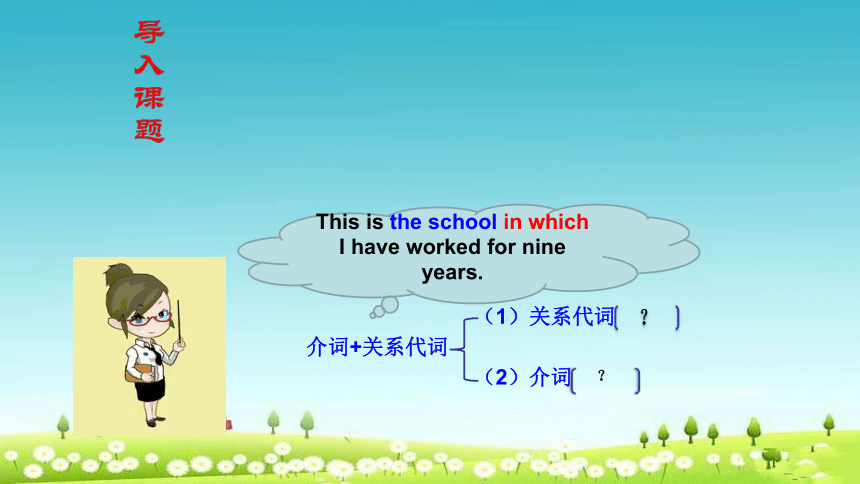
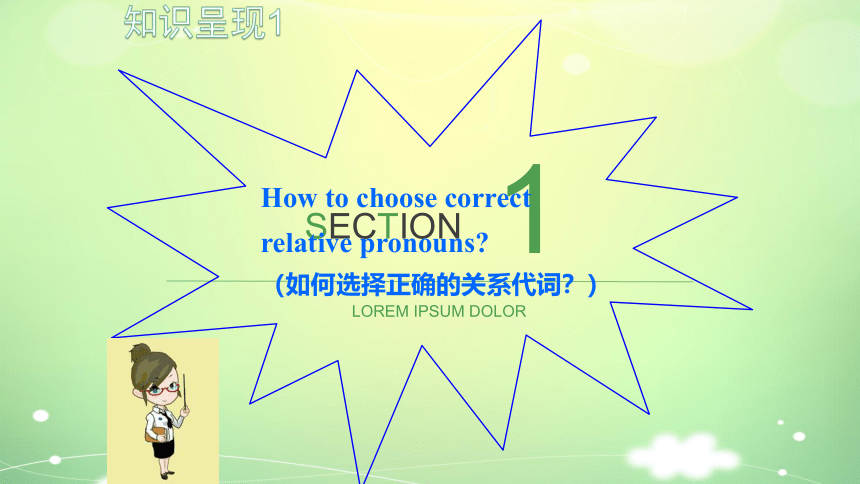
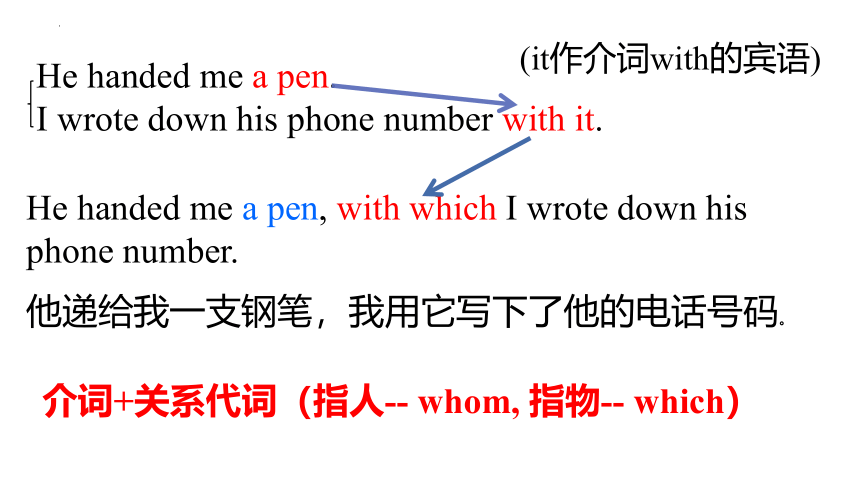
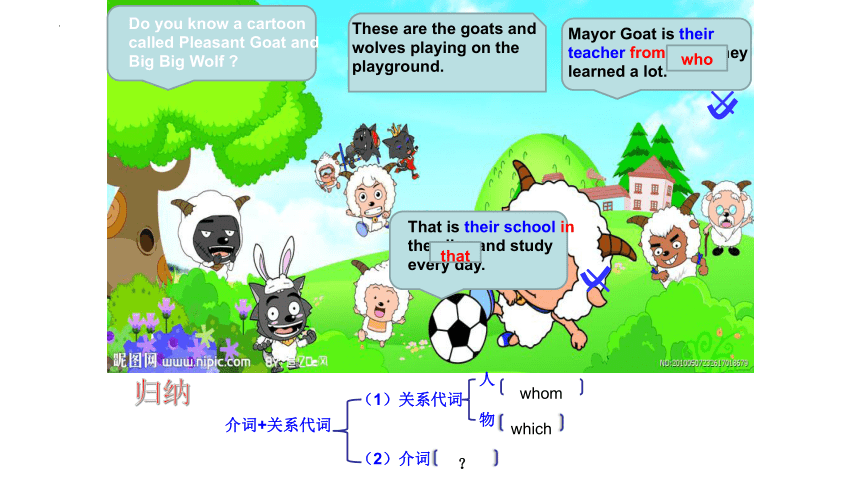
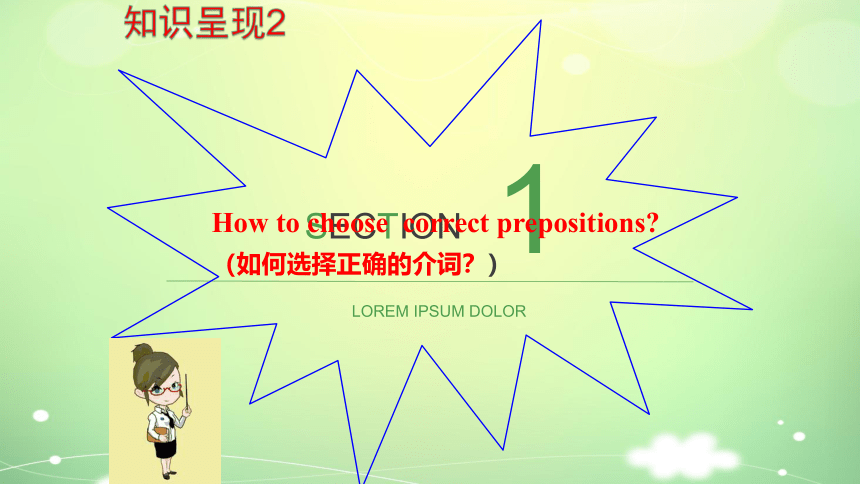

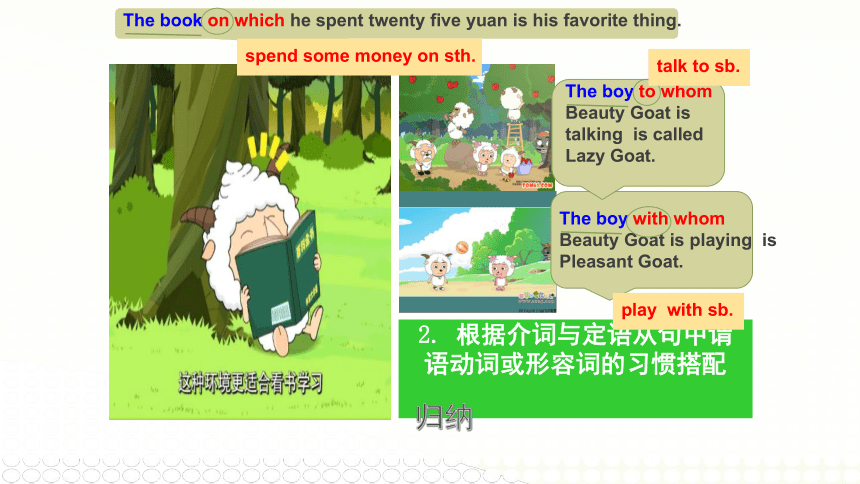
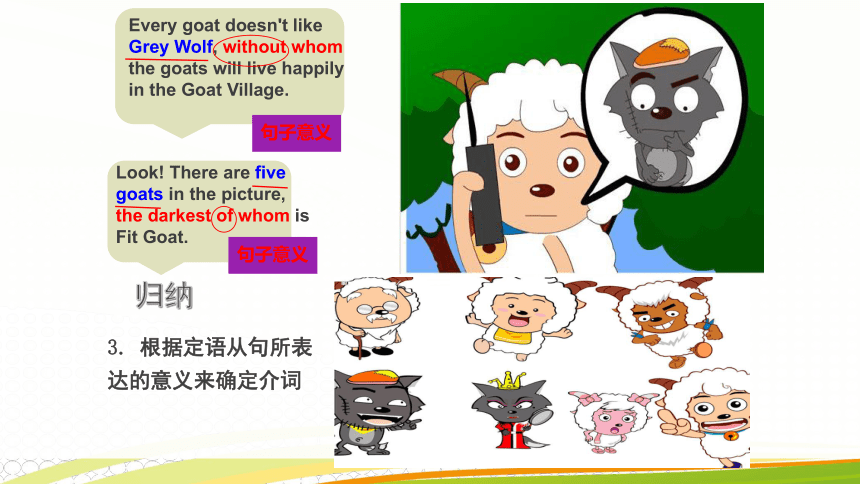
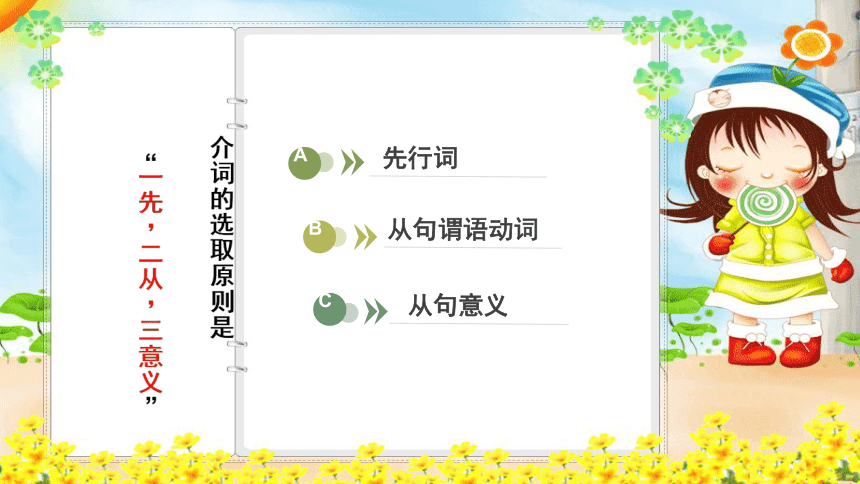

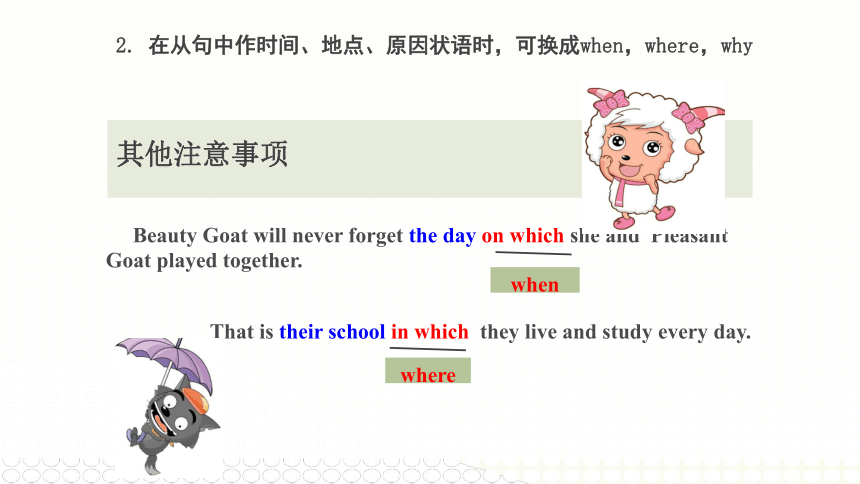
文档简介
(共36张PPT)
Unit 6 At one with nature
Using language
介词+关系代词
(1)关系代词
(2)介词
?
This is the school in which I have worked for nine years.
1
SECTION
LOREM IPSUM DOLOR
How to choose correct
relative pronouns
(如何选择正确的关系代词?)
知识呈现1
He handed me a pen.
I wrote down his phone number with it.
(it作介词with的宾语)
He handed me a pen, with which I wrote down his phone number.
他递给我一支钢笔,我用它写下了他的电话号码。
介词+关系代词(指人-- whom, 指物-- which)
Do you know a cartoon called Pleasant Goat and Big Big Wolf
These are the goats and wolves playing on the playground.
That is their school in they live and study every day.
Mayor Goat is their teacher from they learned a lot.
归纳
介词+关系代词
(1)关系代词
(2)介词
人
物
whom
which
?
whom
×
×
which
who
that
1
SECTION
LOREM IPSUM DOLOR
How to choose correct prepositions
(如何选择正确的介词?)
知识呈现2
LOREM IPSUM DOLOR
Beauty Goat will never forget the day on which she and Pleasant Goat played together.
She will also never forget the days during which Mayor Goat taught them.
But she doesn't like the way in which Grey Wolf treated them.
归纳
1. 根据介词与先行词搭配关系
during the days
on the day
in the way
2. 根据介词与定语从句中谓语动词或形容词的习惯搭配
The boy with whom Beauty Goat is playing is Pleasant Goat.
The boy to whom Beauty Goat is talking is called Lazy Goat.
归纳
talk to sb.
play with sb.
The book on which he spent twenty five yuan is his favorite thing.
spend some money on sth.
Every goat doesn't like Grey Wolf, without whom the goats will live happily in the Goat Village.
Look! There are five goats in the picture, the darkest of whom is Fit Goat.
归纳
3. 根据定语从句所表达的意义来确定介词
句子意义
句子意义
从句谓语动词
从句意义
先行词
A
B
C
其他注意事项
1. 当介词直接置于关系代词之前时,关系代词不省略,且不用that/who;但当介词置于定语从句之中时,关系代词which/whom可以换成that/who,且可以省略。
The Mayor Goat is their teacher from whom they learned a lot.
That is their school in which they live and study every day.
The Mayor Goat is their teacher (whom/who/that) they learned a lot from.
That is their school(which/that) they live and study in every day.
=
=
?
其他注意事项
2. 在从句中作时间、地点、原因状语时,可换成when,where,why
Beauty Goat will never forget the day on which she and Pleasant Goat played together.
That is their school in which they live and study every day.
when
where
(2019年全国Ⅱ卷) First, I wanted to be a fireman, ______ uniform looked so cool.
A.that B. which C. whose D. whom
(2019年全国Ⅲ卷) Lin-Manuel Miranda wrote this musical about Alexander Hamilton, _______ the birth of America is presented as an immigrant story.
A. in which B. for which C. from which D. of which
C
the uniform of whom
A
真题在线
(2019全国Ⅰ卷)They rose in the ranks not by being friendly but by smoking cigarettes, breaking rules and playing jokes on the others, among____ I stood found myself.
A.that B. which C. who D. whom
(2019年全国Ⅱ卷) He likes that he can sit and check his phone in peace or chat up the barkeeper with ______ he’s first-name basis if he wants to have a little interaction.
A.that B. them C. whom D. which
D
C
【课堂小结】
小结
“介词+关系代词”结构
关系 代词 人 whom
物 which
介 词 根据定语从句中的谓语或形容词来确定
根据先行词来确定
根据定语从句所表达的意义来确定
有时需要同时考虑动词和介词的搭配关系及介词和先行词的搭配关系
Grammar: Attributive clauses (3)
where
在定语从句中用作地点状语
先行词须是表时间的名词
when
在定语从句中用作原因状语
在定语从句中用作时间状语
先行词须是表地点的名词
先行词一般是reason(s)
why
Review relative adverbs in attributive clauses.
Look at the sentences from the reading passage and answer the questions.
What does “which” refer to in sentence (a)
Grammar: Attributive clauses (3)
a ... they could increase the areas in which
they could grow rice.
b ... these terraces still mean a lot to the local
people for whom traditions hold much value.
What does “whom” refer to in sentence (b)
Why do we use prepositions before “which” and “whom”
Grammar: Attributive clauses (3)
…they could increase the areas in which they could grow rice.
…these terraces still mean a lot to the local people for whom traditions hold much value.
Because “which” and “whom” serve as the objects of the action phrases that end with a preposition.
In sentence (a), can we replace “in which” with “where” without changing the meaning
Grammar: Attributive clauses (3)
a … they could increase the areas in which
they could grow rice.
Look at the sentences from the reading passage and answer the questions.
Yes.
What is the difference between the two groups of sentences
Grammar: Attributive clauses (3)
a … they could increase the areas in which they could
grow rice.
b … these terraces still mean a lot to the local people
for whom traditions hold much value.
c … they could increase the areas. They could grow
crops in these areas.
d … these terraces still mean a lot to the local people.
Traditions hold much value for them.
Sentences (a) and (b) both contain a clause defining a noun in the sentence.
Sentences (c) and (d) are constructed with a pair of simple sentences, with one defining a noun in the other sentence in each pair.
Why does the author choose to use sentences (a) and (b) in the reading passage
Grammar: Attributive clauses (3)
Because there is a closer link and connection between the item and the clause defining it in sentences (a) and (b). It will also make the passage clearer, and create an emphatic effect on the objects being defined.
指人
指物
介词 + whom
介词 + which
Grammar: Attributive clauses (3)
介词 + 关系代词
Grammar: Attributive clauses (3)
The man______________ the thief was caught was a good policeman.
This is the reason ______________ I was praised by my chemistry teacher.
Exercise
by whom
for which
含有介词的动词固定短语在定语从句中一般不拆开,在这种情况下,介词仍然放在后面,例如 hear from, look after 等。
Grammar: Attributive clauses (3)
Exercise
3) I met the child ___________________ I
looked after ten years ago.
4) I wanted to visit the house ____________
my grandparents lived in.
介词处于句尾时,句中的关系代词可以省略。
(who / whom / that)
(that / which)
Now look for and underline the sentences with attributive clauses in the reading passage.
These terraces were built by the local Zhuang and Yao people, to whom Guangxi is home.
Building the terraces therefore meant that they could increase the areas in which they could grow rice.
But perhaps what is most significant is the way in which people have worked in harmony with nature to make these terraces and grow rice.
Grammar: Attributive clauses (3)
The terraces are cleverly designed, with hundreds of waterways that connect with each other.
This forms clouds from which rain falls down onto the mountain terraces once again.
These terraces also provide a perfect environment for birds and fish, some of which feed on insects that can harm the rice crops.
Now look for and underline the sentences with attributive clauses in the reading passage.
Grammar: Attributive clauses (3)
Although modern technology could help produce more crops, these terraces still mean a lot to the local people for whom traditions hold much value.
This knowledge is passed down through families, which means that new generations continue to use ancient methods of agriculture to maintain the terraces.
Now look for and underline the sentences with attributive clauses in the reading passage.
Grammar: Attributive clauses (3)
Today, the Longji Rice Terraces attract thousands of visitors who come to admire this great wonder created by people and nature working together.
Now look for and underline the sentences with attributive clauses in the reading passage.
Grammar: Attributive clauses (3)
Connect the sentences with a preposition + whom / which.
2. Guangxi is a province. The Longji Rice Terraces
are located in it.
The Zhuang is an ethnic group, of which the population is the largest of all ethnic groups in China.
Guangxi is a province in which the Longji Rice Terraces are located.
Grammar: Attributive clauses (3)
1. The Zhuang is an ethnic group. Its population is
the largest of all ethnic groups in China.
4. He is an expert on rice planting. The local Zhuang
people have learnt a lot from him.
I want to visit this cultural landscape, to which the title of UNESCO World Heritage Site was given in 2016.
He is an expert on rice planting, from whom the local Zhuang people have learnt a lot.
Connect the sentences with a preposition + whom / which.
Grammar: Attributive clauses (3)
3. I want to visit this cultural landscape. The title of
UNESCO World Heritage Site was given to it in 2016.
Grammar: Attributive clauses (3)
Complete the passage with a preposition + whom / which. (P65)
dyes can often be found in gardens 2__________ colorful flowers are planted. Other natural dyes are made from insects, sea creatures and mineral compounds.
Among the many beautiful treasures people can receive from nature are natural dyes. The most common natural source 1___________ natural dyes come is plants.
from which
Materials for making natural
in which
Natural dyes are now returning to popularity, especially with artists and craftspeople. The reasons 3 ___________ they prefer natural dyes are that the colors are brighter and can be kept longer. Natural dyes are also becoming more popular with consumers 4 ________ caring for the environment is a priority. More and more people feel that by using natural dyes, we can remind ourselves of nature’s beauty and protect the natural world.
for which
for whom
Ⅳ
Homework
Homework
Review attributive clauses and do more exercises about them.
Memorize some words about geographical features.
THANK YOU
Unit 6 At one with nature
Using language
介词+关系代词
(1)关系代词
(2)介词
?
This is the school in which I have worked for nine years.
1
SECTION
LOREM IPSUM DOLOR
How to choose correct
relative pronouns
(如何选择正确的关系代词?)
知识呈现1
He handed me a pen.
I wrote down his phone number with it.
(it作介词with的宾语)
He handed me a pen, with which I wrote down his phone number.
他递给我一支钢笔,我用它写下了他的电话号码。
介词+关系代词(指人-- whom, 指物-- which)
Do you know a cartoon called Pleasant Goat and Big Big Wolf
These are the goats and wolves playing on the playground.
That is their school in they live and study every day.
Mayor Goat is their teacher from they learned a lot.
归纳
介词+关系代词
(1)关系代词
(2)介词
人
物
whom
which
?
whom
×
×
which
who
that
1
SECTION
LOREM IPSUM DOLOR
How to choose correct prepositions
(如何选择正确的介词?)
知识呈现2
LOREM IPSUM DOLOR
Beauty Goat will never forget the day on which she and Pleasant Goat played together.
She will also never forget the days during which Mayor Goat taught them.
But she doesn't like the way in which Grey Wolf treated them.
归纳
1. 根据介词与先行词搭配关系
during the days
on the day
in the way
2. 根据介词与定语从句中谓语动词或形容词的习惯搭配
The boy with whom Beauty Goat is playing is Pleasant Goat.
The boy to whom Beauty Goat is talking is called Lazy Goat.
归纳
talk to sb.
play with sb.
The book on which he spent twenty five yuan is his favorite thing.
spend some money on sth.
Every goat doesn't like Grey Wolf, without whom the goats will live happily in the Goat Village.
Look! There are five goats in the picture, the darkest of whom is Fit Goat.
归纳
3. 根据定语从句所表达的意义来确定介词
句子意义
句子意义
从句谓语动词
从句意义
先行词
A
B
C
其他注意事项
1. 当介词直接置于关系代词之前时,关系代词不省略,且不用that/who;但当介词置于定语从句之中时,关系代词which/whom可以换成that/who,且可以省略。
The Mayor Goat is their teacher from whom they learned a lot.
That is their school in which they live and study every day.
The Mayor Goat is their teacher (whom/who/that) they learned a lot from.
That is their school(which/that) they live and study in every day.
=
=
?
其他注意事项
2. 在从句中作时间、地点、原因状语时,可换成when,where,why
Beauty Goat will never forget the day on which she and Pleasant Goat played together.
That is their school in which they live and study every day.
when
where
(2019年全国Ⅱ卷) First, I wanted to be a fireman, ______ uniform looked so cool.
A.that B. which C. whose D. whom
(2019年全国Ⅲ卷) Lin-Manuel Miranda wrote this musical about Alexander Hamilton, _______ the birth of America is presented as an immigrant story.
A. in which B. for which C. from which D. of which
C
the uniform of whom
A
真题在线
(2019全国Ⅰ卷)They rose in the ranks not by being friendly but by smoking cigarettes, breaking rules and playing jokes on the others, among____ I stood found myself.
A.that B. which C. who D. whom
(2019年全国Ⅱ卷) He likes that he can sit and check his phone in peace or chat up the barkeeper with ______ he’s first-name basis if he wants to have a little interaction.
A.that B. them C. whom D. which
D
C
【课堂小结】
小结
“介词+关系代词”结构
关系 代词 人 whom
物 which
介 词 根据定语从句中的谓语或形容词来确定
根据先行词来确定
根据定语从句所表达的意义来确定
有时需要同时考虑动词和介词的搭配关系及介词和先行词的搭配关系
Grammar: Attributive clauses (3)
where
在定语从句中用作地点状语
先行词须是表时间的名词
when
在定语从句中用作原因状语
在定语从句中用作时间状语
先行词须是表地点的名词
先行词一般是reason(s)
why
Review relative adverbs in attributive clauses.
Look at the sentences from the reading passage and answer the questions.
What does “which” refer to in sentence (a)
Grammar: Attributive clauses (3)
a ... they could increase the areas in which
they could grow rice.
b ... these terraces still mean a lot to the local
people for whom traditions hold much value.
What does “whom” refer to in sentence (b)
Why do we use prepositions before “which” and “whom”
Grammar: Attributive clauses (3)
…they could increase the areas in which they could grow rice.
…these terraces still mean a lot to the local people for whom traditions hold much value.
Because “which” and “whom” serve as the objects of the action phrases that end with a preposition.
In sentence (a), can we replace “in which” with “where” without changing the meaning
Grammar: Attributive clauses (3)
a … they could increase the areas in which
they could grow rice.
Look at the sentences from the reading passage and answer the questions.
Yes.
What is the difference between the two groups of sentences
Grammar: Attributive clauses (3)
a … they could increase the areas in which they could
grow rice.
b … these terraces still mean a lot to the local people
for whom traditions hold much value.
c … they could increase the areas. They could grow
crops in these areas.
d … these terraces still mean a lot to the local people.
Traditions hold much value for them.
Sentences (a) and (b) both contain a clause defining a noun in the sentence.
Sentences (c) and (d) are constructed with a pair of simple sentences, with one defining a noun in the other sentence in each pair.
Why does the author choose to use sentences (a) and (b) in the reading passage
Grammar: Attributive clauses (3)
Because there is a closer link and connection between the item and the clause defining it in sentences (a) and (b). It will also make the passage clearer, and create an emphatic effect on the objects being defined.
指人
指物
介词 + whom
介词 + which
Grammar: Attributive clauses (3)
介词 + 关系代词
Grammar: Attributive clauses (3)
The man______________ the thief was caught was a good policeman.
This is the reason ______________ I was praised by my chemistry teacher.
Exercise
by whom
for which
含有介词的动词固定短语在定语从句中一般不拆开,在这种情况下,介词仍然放在后面,例如 hear from, look after 等。
Grammar: Attributive clauses (3)
Exercise
3) I met the child ___________________ I
looked after ten years ago.
4) I wanted to visit the house ____________
my grandparents lived in.
介词处于句尾时,句中的关系代词可以省略。
(who / whom / that)
(that / which)
Now look for and underline the sentences with attributive clauses in the reading passage.
These terraces were built by the local Zhuang and Yao people, to whom Guangxi is home.
Building the terraces therefore meant that they could increase the areas in which they could grow rice.
But perhaps what is most significant is the way in which people have worked in harmony with nature to make these terraces and grow rice.
Grammar: Attributive clauses (3)
The terraces are cleverly designed, with hundreds of waterways that connect with each other.
This forms clouds from which rain falls down onto the mountain terraces once again.
These terraces also provide a perfect environment for birds and fish, some of which feed on insects that can harm the rice crops.
Now look for and underline the sentences with attributive clauses in the reading passage.
Grammar: Attributive clauses (3)
Although modern technology could help produce more crops, these terraces still mean a lot to the local people for whom traditions hold much value.
This knowledge is passed down through families, which means that new generations continue to use ancient methods of agriculture to maintain the terraces.
Now look for and underline the sentences with attributive clauses in the reading passage.
Grammar: Attributive clauses (3)
Today, the Longji Rice Terraces attract thousands of visitors who come to admire this great wonder created by people and nature working together.
Now look for and underline the sentences with attributive clauses in the reading passage.
Grammar: Attributive clauses (3)
Connect the sentences with a preposition + whom / which.
2. Guangxi is a province. The Longji Rice Terraces
are located in it.
The Zhuang is an ethnic group, of which the population is the largest of all ethnic groups in China.
Guangxi is a province in which the Longji Rice Terraces are located.
Grammar: Attributive clauses (3)
1. The Zhuang is an ethnic group. Its population is
the largest of all ethnic groups in China.
4. He is an expert on rice planting. The local Zhuang
people have learnt a lot from him.
I want to visit this cultural landscape, to which the title of UNESCO World Heritage Site was given in 2016.
He is an expert on rice planting, from whom the local Zhuang people have learnt a lot.
Connect the sentences with a preposition + whom / which.
Grammar: Attributive clauses (3)
3. I want to visit this cultural landscape. The title of
UNESCO World Heritage Site was given to it in 2016.
Grammar: Attributive clauses (3)
Complete the passage with a preposition + whom / which. (P65)
dyes can often be found in gardens 2__________ colorful flowers are planted. Other natural dyes are made from insects, sea creatures and mineral compounds.
Among the many beautiful treasures people can receive from nature are natural dyes. The most common natural source 1___________ natural dyes come is plants.
from which
Materials for making natural
in which
Natural dyes are now returning to popularity, especially with artists and craftspeople. The reasons 3 ___________ they prefer natural dyes are that the colors are brighter and can be kept longer. Natural dyes are also becoming more popular with consumers 4 ________ caring for the environment is a priority. More and more people feel that by using natural dyes, we can remind ourselves of nature’s beauty and protect the natural world.
for which
for whom
Ⅳ
Homework
Homework
Review attributive clauses and do more exercises about them.
Memorize some words about geographical features.
THANK YOU
